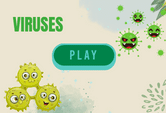Viruses Game Quiz Online
This page contains a Viruses Game Quiz Online. Learn about viruses, how they spread and how they make us ill. A virus, based on its structure, is not a living thing. In spite of its status and microscopic nature, the impact of viruses on society is felt through the different diseases they cause. The world is currently dealing with the corona viruses that are causing a lot of deaths. In this game, students will answer 15 multiple choice questions about viruses. It is a test for students studying science in 3rd, 4th, 5th, 6th to 8th grades. This game will work in the classroom and at home as a supplementary learning material. Have fun.

Viruses and Their Impact on Our Daily Lives
Viruses are infectious submicroscopic particles that replicate only inside living cells. They infect all forms of life including plants, animals, microorganisms, archaea, and bacteria. Viruses have been responsible for numerous deaths and illnesses and have led to the development of vaccines to combat the spread of disease. Here's a closer look at viruses and their impact on our daily lives. Read on to learn more about the viruses that are currently making the rounds.
Viruses currently going around
Viruses currently going around are not always dangerous. A good example is the flu. Infection prevention specialist Dr. Christopher Belcher says it's best to protect yourself against the flu virus. While it doesn't cause severe illness, it can make people feel ill. He recommends that everyone get a flu vaccine if they haven't had one in the past. The corona virus is another virus that has been on the rise since 2019. Vaccines have been developed to combat the epidemic but the results are still lacking and scientists are still working on a much more effective vaccine.
How many viruses have been eradicated by vaccines
Vaccination has made a huge contribution to global health, with two major infections having been eliminated or almost eliminated. Since the creation of the WHO's Expanded Programme of Immunization (EPI) in 1974 and the Global Alliance for Vaccination and Immunization in 2000, vaccine coverage has soared. For example, polio has almost disappeared completely, and measles has been controlled to a tiny number of cases in the United States. However, while vaccines have made huge advances in controlling some diseases, a vast majority of child deaths still result from infections.
The smallpox virus was eradicated worldwide in 1972 and polio eliminated from the world in 1979. The diphtheria vaccine was introduced in the 1920s. Today, mumps only affects a few hundred people in the U.S. per year. Vaccines have made these viruses rare and a thing of the past. While this is certainly good news for the world, there are still a few potential candidates for eradication.
While the smallpox virus is one of the oldest known pathogens, it is easier to eradicate than diseases with multiple closely related viruses. The vaccine for smallpox was designed to target both types of variola virus and prevent the other. In contrast, pneumonia has many pathogens and requires different treatments to ensure complete immunity. The World Health Organization has registered 741,000 cases of these three diseases in 2017.
There are still challenges with this approach. Increasing the uptake of old 'EPI' vaccines is a major challenge, as are the introduction of recently developed vaccines in low and middle-income countries. Fortunately, the vast majority of children will receive vaccinations in the future, and the scope of these vaccinations will expand in the coming decades. The benefits of vaccines are clear. These vaccines are a vital part of protecting the world's population against disease.
Why viruses are not considered living things
Viruses are not considered living because they are incapable of producing their own energy and depend on their hosts for their metabolism. In contrast, cells produce their own energy. Because viruses lack cells, they cannot reproduce independently. They are inert packages of DNA and RNA, and they cannot replicate without the assistance of a host cell. Their genomes also lack cell membranes and organelles. As a result, scientists do not consider them living.
The simplest way to understand why viruses are not considered living things is by considering their lack of internal energy and temperature regulation mechanisms. Viruses do not produce ATP, which is the energy currency of life. Their only energy requirement is to drift around and infect cells in order to make more copies of themselves. Viruses are not limited in their movements. In fact, they have evolved to become the most efficient propagators of genetic information.
Why viruses are not considered living things raises a fundamental issue: what constitutes life? While a precise scientific definition of life is hard to come by, most observers agree that life comprises certain qualities. In particular, living entities undergo a state of birth and death. In addition, biochemical autonomy is necessary to sustain an organism. While the definition of life may be vague, living entities are generally considered to require a certain level of biochemical autonomy to produce the energy and molecules needed to sustain them.
However, scientists disagree about the role of viruses in evolution. Some evolutionary biologists view viruses as inanimate, but say they play a critical role in the process of evolution. Viruses, in fact, share many genetic characteristics with their hosts, and have evolved to withstand different environmental challenges. Some researchers even argue that viruses are a fourth domain of life. That makes them unique in their own right.
